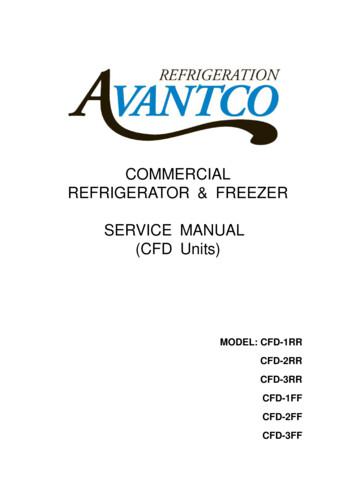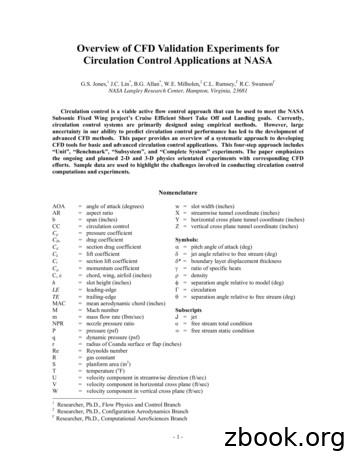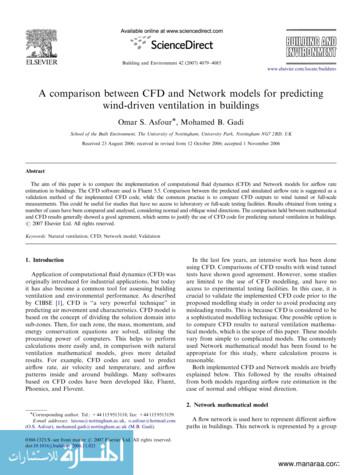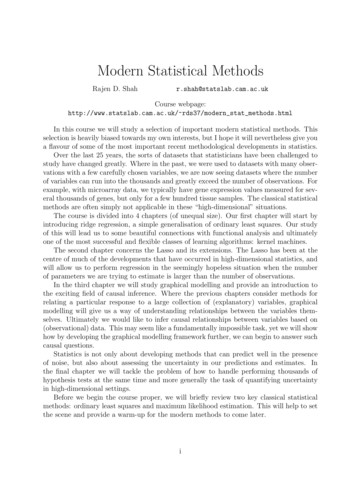CFD METHODOLOGY AND VALIDATION FOR SINGLE-PHASE FLOW
XCFD4NRS – Experiments and CFD Codes Application to Nuclear Reactor SafetyOECD/NEA & IAEA WorkshopGrenoble, France, 10 -12 September 2008CFD METHODOLOGY AND VALIDATION FOR SINGLE-PHASE FLOWIN PWR FUEL ASSEMBLIESMichael E. Conner 1,*, Emilio Baglietto 2, Abdelaziz M. Elmahdi 112Westinghouse Nuclear Fuel, 5801 Bluff Road, Columbia, South Carolina, USA 29250CD-adapco, New York Office, 60 Broadhollow Road, Melville, New York, USA 11747*Corresponding Author; Tel: 1-803-647-3685, connerme@westinghouse.comAbstract – This paper presents the CFD modeling methodology and validation for steady-state,normal operation in a PWR fuel assembly. This work is part of a program that is developing aCFD methodology for modeling and predicting single-phase and two-phase flow conditionsdownstream of structural grids that have mixing devices. The purpose of the mixing devices(mixing vanes in this case) is to increase turbulence and improve heat transfer characteristics ofthe fuel assembly. The detailed CFD modeling methodology for single-phase flow conditions inPWR fuel assemblies was developed using the STAR-CD CFD code. This methodology includesthe details of the computational mesh, the turbulence model used, and the boundary conditionsapplied to the model. The methodology was developed by benchmarking CFD results versussmall-scale experiments. The experiments use PIV to measure the lateral flow field downstreamof the grid, and thermal testing to determine the heat transfer characteristics of the rodsdownstream of the grid. The CFD results and experimental data presented in the paper providevalidation of the single-phase flow modeling methodology. Two-phase flow CFD models arebeing developed to investigate two-phase conditions in PWR fuel assemblies, and these can bepresented at a future CFD Workshop.1. INTRODUCTIONTraditionally, the key thermal performance parameter for Pressurized Water Reactors (PWR) fuelhas been the critical heat flux (CHF). This parameter has been defined and used to ensure that thenuclear reactor core is operated in a manner that maintains safe operation even during assumed failureevents. In recent PWR operation in the United States, several leaking fuel rod events have occurredresulting from excessive local crud build up on the fuel rod. The excessive crud build up occurreddue to local subcooled boiling during steady-state, normal operation. With a trend in the US PWRplants toward increased power upratings, longer cycles, and higher fuel burnup, understanding thelocal conditions in a PWR fuel assembly has become necessary to minimize the risk of future crudleakers in PWR fuel.Therefore, both single-phase normal operation and two-phase accident conditions are of interestfor investigation for PWR cores. Local subchannel and fuel rod thermal-hydraulic conditions need tobe obtained and understood. Thermal-hydraulic testing is important in understanding criticalparameters, such as CHF. However, testing can only provide limited information at specific locationswhere the instrumentation is placed. Computational Fluid Dynamics (CFD) can be used to calculatekey parameters in the whole modeling domain. Of course, the complex flow field in a PWR withmixing vanes provides a very challenging problem for CFD. Therefore, a rigorous benchmarkingeffort is needed to ensure that the CFD results obtained are reasonable.Two-phase flow is much more complex to measure, model, and understand than single-phaseflow. This is especially true in nuclear fuel assemblies which implement mixing vanes on thestructural grids. Therefore, it is logical to start with CFD models of single-phase conditions. Then,when the methodology is developed with confidence on single-phase applications, application of 2phase conditions can be developed. Not only does this strategy make sense from the complexity ofthe physics, it also makes sense from a benchmark testing perspective (single-phase testing is muchPage 1 of 12
XCFD4NRS – Experiments and CFD Codes Application to Nuclear Reactor SafetyOECD/NEA & IAEA WorkshopGrenoble, France, 10 -12 September 2008easier and less costly) and CFD modeling perspective (two-phase flow CFD is more sensitive to gridquality and requires larger memory and longer computational time).This paper presents the Westinghouse CFD methodology to model single-phase, steady-stateconditions in PWR fuel assemblies. In support of this, a description of the benchmark testing used toqualify the methodology has been provided. As a validation case, a CFD model of the full lateraldomain of a 5x5 rod bundle test geometry is discussed, and results are compared against test data.Now that this knowledge and experience has been gained, two-phase flow CFD models are beingdeveloped to investigate two-phase conditions in PWR fuel assemblies. The methodology and resultsfrom that effort can be presented at a future CFD Workshop.2. PWR CFD METHODOLOGY DEVELOPMENTWestinghouse has been using Computational Fluid Dynamics (CFD) to model the flowdownstream of grids with mixing vanes in PWR fuel assemblies for over 10 years. Westinghouse hasworked closely with CD-adapco (maker of STAR-CD CFD code) to develop a methodology thatcreates CFD models that effectively predict the flow field and heat transfer within a PWR fuel rodbundle.An initial CFD application was to investigate the crud related fuel failures that occurred in highpowered 17x17 Westinghouse fuel assemblies at Seabrook Station Nuclear Power Plant. A twosubchannel CFD model was created and run. CFD results show good qualitative results compared toPost Irradiation Examinations (PIE); specifically high temperature streaks (in the axial direction) inthe CFD model were very similar to crud deposit streaks on the actual fuel rods.To quantitatively benchmark the CFD results and provide confidence in the detailed results,small-scale experiments (i.e., 5x5 rod bundle versus full size 17x17 rod bundle) have been developed.To investigate the flow field downstream of mixing vanes, a testing methodology was developed tomeasure the lateral flow field at various elevations downstream of the grid. Particle ImageVelocimetry is the technique used in this testing (McClusky, 2002). To investigate the average heattransfer coefficient, a testing methodology was developed to measure the heat transfer coefficient as afunction of axial distance downstream of the grid (Holloway, 2004). To investigate the axial streaksof high temperature and crud deposition, a testing methodology was developed to investigate theazimuthal heat transfer coefficient variation around the fuel rod (Holloway, 2005). All of thisbenchmark test data was obtained at low temperature and Reynolds number.A CFD model was developed to predict some of this benchmark test data. The mesh, turbulencemodel, computational domain, and boundary conditions were used to improve the CFD predictionversus the test data. The final CFD model showed reasonable agreement versus the test data (Smith,2002). With confidence established between the CFD model methodology and test data, applicationof CFD modeling was extended to PWR conditions, which are at higher temperature and Reynoldsnumber versus the benchmark data.To improve the heat transfer test data, a test methodology was developed that utilized fully-heatedrods over the entire axial grid span (Conner, 2005). All of the rods in the 5x5 test bundle were heatedover several grid spans to provide the appropriate thermal boundary condition for heat transfermeasurements. Air was used as the fluid to reduce the power required to heat the rods. A speciallydesigned thermocouple holder that could be moved axially down the rod bundle and azimuthallywithin a test rod was developed and used in this testing. This testing methodology was used toprovide detailed heat transfer data for different mixing vane designs.To do comparisons between different mixing vane designs, a larger lateral domain is needed inthe CFD model. Test data shows that just downstream of the mixing vanes, the lateral flow field isdominated by the vanes and the CFD lateral domain is not important. However, further downstreamPage 2 of 12
XCFD4NRS – Experiments and CFD Codes Application to Nuclear Reactor SafetyOECD/NEA & IAEA WorkshopGrenoble, France, 10 -12 September 2008of the grid and approaching the next grid, the overall vane pattern and lateral boundary conditionshave an important effect on the flow within a subchannel. This is seen in the test data (McClusky,2003). Fortunately, the computing speed of computers and CFD solvers has improved dramaticallyover the last 10 years. Therefore, transitioning from a two subchannel model to the 36 subchannels(5x5 rod bundle) in a test has become achievable. Therefore, a direct comparison can be madebetween the CFD model results and the experimental results of the same lateral geometry.As can we seen above, the CFD methodology has evolved over time with an iterative process. Anexample of a step in the CFD methodology development is as follows: A CFD model is created based on the best known modeling practices and/or results ofcomparison with benchmark data. Results of the CFD model show a new hydraulic or thermal characteristic of the rodbundle that needs validation. A new experiment is developed to investigate the new characteristic. The new test data quantifies the hydraulic/thermal characteristic. If the CFD prediction does not predict the new test data well, the CFD modelingmethodology is improved so that it captures the characteristic adequately.The paper shows the test data and CFD results for a 5x5 rod bundle test. Comparison of the dataand predictions provides validation of the single-phase flow CFD modeling methodology that wasdeveloped using the benchmark data described above.3. MIXING VANE GRID VALIDATION CASETo demonstrate the CFD methodology, a validation case of a 5x5 rod bundle is presented in thispaper. The 5x5 rod bundle uses a concept grid (neither the mixing vane design nor the grid strapdesign is used in actual PWR fuel assemblies). This concept grid provides similar flow field and heattransfer characteristics as actual PWR grid designs. Therefore, this concept grid provides a goodvalidation case.The 5x5 rod bundle evaluated in the validation case is representative of a 17x17 fuel assemblydesign. The rod bundle pitch (12.6 mm), rod diameter (9.5 mm), and grid features are identical to a17x17 fuel assembly. The only reduction in scale is in the overall 5x5 array versus a 17x17 array.The 5x5 rod bundle does not contain any thimble tubes, so it has 25 simulated fuel rods. The conceptgrid used in this validation case is shown in Figure 1.Fig. 1: 5x5 Concept Grid used as CFD Validation Case.Page 3 of 12
XCFD4NRS – Experiments and CFD Codes Application to Nuclear Reactor SafetyOECD/NEA & IAEA WorkshopGrenoble, France, 10 -12 September 2008The 5x5 concept grid and associated rod bundle were modelled in CFD. Modelling of the entirelateral domain has the advantage of allowing direct comparison between the CFD model results andexperimental results of the same geometry. The CFD model is described in Section 4. Experimentaldata was obtained from a 5x5 test bundle which used this concept grid design. Data from this testingis described in Section 5. Comparison of the CFD results and the test data is provided in Section 6.Benchmark data from the experiments were obtained at low temperature and Reynolds number.In contrast, the CFD evaluation was run at in-core conditions so that heat flux values could be usedthat are typical of PWRs. This results in a large difference in the Reynolds number from the testingversus the CFD results. Impacts of this Reynolds number difference are discussed as part of the datacomparison.4. CFD ANALYSISThe CD-adapco code STAR-CD has been the primary CFD platform for investigation of singlephase flow and heat transfer in PWR fuel rod bundles at Westinghouse. Westinghouse has used thethree leading general purpose commercial CFD codes (STAR-CD, Fluent, and CFX) in PWR rodbundle modeling (Liu, 2005). Based on extensive benchmarking of CFD results, experience withvarious sized rod bundle arrays (i.e, 2-subchannel, 5x5 rod array, etc.), and a successful partnershipwith CD-adapco, Westinghouse has developed a CFD methodology for fuel rod bundle modeling thatuses the STAR-CD code. The STAR-CD code generates high quality grids and contains accuratenumeral schemes and turbulence models which lead to good results versus benchmark test data.The CFD methodology used in single-phase flow and heat transfer modeling in PWRs isdiscussed in this section. The specific 5x5 rod bundle CFD model discussed in this section is used inthe validation case described in Section 3. The conditions for this CFD evaluation are in-coreconditions at an average axial velocity of 5.7 m/s.Fig. 2: Trimmed hexahedral mesh detail near the upper section of the spacer.4.1 Mesh GenerationThe model of one span length of a 5x5 nuclear fuel rod bundle, including the very complex gridspacer and mixing vane area, has been created using the pre-processing capabilities of the codeSTAR-CD. The software allows generating a high quality, predominantly hexahedral, unstructuredgrid; Figure 2 shows a representative detail of the mesh in region of the spacer surrounding one fuelPage 4 of 12
XCFD4NRS – Experiments and CFD Codes Application to Nuclear Reactor SafetyOECD/NEA & IAEA WorkshopGrenoble, France, 10 -12 September 2008rod. The core region is composed of uniform cubic hex cells, the grid is consistently refined inproximity to all walls, and a multi layer of body fitted hex cells is adopted in the near wall region andconnected to the core grid with the use of trimmed transition elements.The adopted meshing approach allows placing a sufficient number of computational pointsefficiently, even in complex regions such as the springs of the fuel spacer, as shown in Figure 3, andto maintain the turbulence model wall treatment requirements as a result of the precise location ofnear wall cells. In order to further reduce the number of necessary grid points, while cubic hex cellsare adopted in the spacer region, elongated hex elements are used further away, as represented inFigure 4 where both the stretching, preceding and following the spacer, are presented.Fig. 3: Mesh detail in the spacer spring region.FlowFig. 4: Mesh section showing the axial stretching away from the spacer region.Page 5 of 12
XCFD4NRS – Experiments and CFD Codes Application to Nuclear Reactor SafetyOECD/NEA & IAEA WorkshopGrenoble, France, 10 -12 September 2008The use of flow aligned cubic hex cells has the clear advantage of guaranteeing the grid quality,and eliminating aspect ratio and skeweness issues typical of tetrahedral meshes. Furthermore thisapproach guarantees the consistency of the grid refinement study. In the present work the absolutesizing of the computational cells has been derived from previous mesh convergence studies on areduced 2x1 rods configuration, where they have demonstrated the ability of accurately capturing theaverage and local flow and thermal fields. The total size of the mesh is about 20 Million cells.4.2 Discretization Practices and Turbulence ModellingThe numerical method of the STAR-CD code is based on a finite volume approach onunstructured grids. STAR-CD provides a large variety of differencing schemes for both temporal andspatial discretization of the momentum and energy equations, which can be used to solve 3D steadyand transient problems; in this work steady state calculations have been performed by entirelydispensing with the temporal derivatives and iterating to the steady state with the help of underrelaxation.As is well known, the discretization practices, together with the discussed grid quality, requirespecial attention in order to guarantee the independency and accuracy of the results. The adoptedsecond order discretization for momentum and turbulence quantities with a first order discretizationfor the temperature field, in combination with the high quality trimmed mesh, has demonstrated itsvalidity in a large series of benchmarks, and in the present work has been further validated in separateanalyses, confirming the ability to accurately capture the average and local peaks in heat transfer (Liu,2005).The applicability of turbulence models to the simulation of fuel rod bundles has been tested andvalidated by Westinghouse in their extensive research (Smith, 2002), and the renormalization group(RNG) k-ε model (Yakhot, 1992) had been found to produce the closest agreement with availableexperimental data. The improvement in the prediction obtained with the RNG model is assumed to berelated to the somewhat inherited sensitivity to curvature and rotation contained in its turbulencedissipation rate equation. The model is applied in conjunction with a law-of-the-wall where thediscussed boundary fitted grid construction near the walls, with local control of mesh thickness,results in Y values for the first computational points between 40 and 100.4.3 Computation Domain and Boundary ConditionsThe optimal mesh construction and efficient parallel solution performances of the CFD code haveallowed modelling a complete one span region of a 5x5 bundle configuration; the capability ofextending the simulation domain to a 5x5 bundle carries the significant advantage of being able todirectly link the results with the hydraulic and heat transfer test performance. The steady statesimulations of the discussed 20 million cells mesh have required 18 hours of computation to reach fullconvergence, using 14 Opteron 2.0 GHz CPUs in a LINUX cluster.Since only one span of the whole assembly is represented in the CFD model, some assumptionsneed to be made in regard to the boundary conditions. In order to correctly reproduce the experimentalsetup, on the reduced computational model, consecutive calculation would need to be performed inwhich the outlet results of a calculation is mapped as inlet for the following run, (partial cyclicboundary conditions could also be used to model an infinite series of spacers). Previous experiencehas shown that the highly turbulent conditions and the strong influence of the spacer geometry allowadopting a simpler Inlet/Outlet configuration, producing almost identical prediction as a partial cyclicboundary condition in the region of interest, i.e. past the spacer grid. A schematic of the model andlocation of the boundaries and reference frames is shown in Figure 5.Uniform inlet velocity and temperature profiles have therefore been applied at the inlet plane,which is located 10 hydraulic diameters upstream of the mixing grid, a flow split boundary conditionPage 6 of 12
XCFD4NRS – Experiments and CFD Codes Application to Nuclear Reactor SafetyOECD/NEA & IAEA WorkshopGrenoble, France, 10 -12 September 2008is applied at the outlet and no-slip conditions are used for the fuel rods, spacer geometry, and walls ofthe flow housing. Regarding the thermal boundary conditions, a rod-by-rod heat flux distribution isadopted. Azimuthally uniform heat flux is imposed in the calculations so that variations in the HTCwill only be related to the flow, and furthermore the heat flux is imposed directly to the fluid so thatconduction through the fuel rod is neglected, emphasizing the local flow effects on the rod surfacetemperature distribution (as previously shown by Liu, 2005).OutletFlowyy 0xSpacerInletFig. 5: Modelled 1 span flow domain.5. TEST DATAThe 5x5 rod bundle with the concept grid design was tested using the experimental techniquesintroduced in Section 2. Each of the experimental techniques used a 5x5 rod bundle array like thesketch shown in Figure 6.CONDITIONING GRIDSTEST GRIDRODSAAFLOW DIRECTIONFig. 6: Sketch of 5x5 Test Bundle(AA Azimuthal Angle)All of the experimental test data discussed in this paper was obtained at low temperature andReynolds number. For the data described in Sections 5.1, 5.2, and 5.3, wat
downstream of the grid. The CFD results and experimental data presented in the paper provide validation of the single-phase flow modeling methodology. Two-phase flow CFD models are being developed to investigate two-phase conditions in PWR fuel assemblies, and these can be presented at a future CFD Workshop. 1. INTRODUCTION
refrigerator & freezer . service manual (cfd units) model: cfd-1rr . cfd-2rr . cfd-3rr . cfd-1ff . cfd-2ff . cfd-3ff . 1 table of contents
Bruksanvisning för bilstereo . Bruksanvisning for bilstereo . Instrukcja obsługi samochodowego odtwarzacza stereo . Operating Instructions for Car Stereo . 610-104 . SV . Bruksanvisning i original
developing experimental and computational databases for improving CC prediction capability. In general, CFD validation is defined by determining how well the CFD model predicts the performance and flow physics when used for its intended purposes.iv The level of CFD validation can be
430 allocation to elianto cfd o&m 20,577.32 440 allocation to trillium west cfd o&m 27,267.00 450 allocation to west park cfd o&m 70,008.22 460 allocation to festival ranch cfd o&m 177,790.54 480 allocation to tartesso west cfd o&m 27,809.17 481 allocation to anthem sun valley cfd o&
The CFD software used i s Fluent 5.5. Comparison between the predicted and simulated airflow rate is suggested as a validation method of the implemented CFD code, while the common practice is to compare CFD outputs to wind tunnel or full-scale . Both implemented CFD and Network models are briefly explained below. This followed by the .
10 tips och tricks för att lyckas med ert sap-projekt 20 SAPSANYTT 2/2015 De flesta projektledare känner säkert till Cobb’s paradox. Martin Cobb verkade som CIO för sekretariatet för Treasury Board of Canada 1995 då han ställde frågan
service i Norge och Finland drivs inom ramen för ett enskilt företag (NRK. 1 och Yleisradio), fin ns det i Sverige tre: Ett för tv (Sveriges Television , SVT ), ett för radio (Sveriges Radio , SR ) och ett för utbildnings program (Sveriges Utbildningsradio, UR, vilket till följd av sin begränsade storlek inte återfinns bland de 25 största
eral thousands of genes, but only for a few hundred tissue samples. The classical statistical methods are often simply not applicable in these \high-dimensional" situations. The course is divided into 4 chapters (of unequal size). Our rst chapter will start by introducing ridge regression, a simple generalisation of ordinary least squares. Our study of this will lead us to some beautiful .























